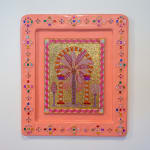Jorge Mañes Rubio
La palma me llevó el alma
Sequins, glass beads and gold leaf on canvas; wood, clay, plaster, gesso, acrylic and glass rhinestones.
80 x 70 x 5 cm
Series: New Prophets
Meer afbeeldingen
-
(View a larger image of thumbnail 1
)

-
(View a larger image of thumbnail 2
)

-
(View a larger image of thumbnail 3
)

-
(View a larger image of thumbnail 4
)

-
(View a larger image of thumbnail 5
)

-
(View a larger image of thumbnail 6
)

-
(View a larger image of thumbnail 7
)

-
(View a larger image of thumbnail 8
)

-
(View a larger image of thumbnail 9
)

-
(View a larger image of thumbnail 10
)

-
(View a larger image of thumbnail 11
)

-
(View a larger image of thumbnail 12
)

-
(View a larger image of thumbnail 13
)

-
(View a larger image of thumbnail 14
)

-
(View a larger image of thumbnail 15
)

-
(View a larger image of thumbnail 16
)

-
(View a larger image of thumbnail 17
)

-
(View a larger image of thumbnail 18
)

-
(View a larger image of thumbnail 19
)

-
(View a larger image of thumbnail 20
)

-
(View a larger image of thumbnail 21
)

-
(View a larger image of thumbnail 22
)

This work features a distinctive horseshoe arch and a date palm tree. They both stand together as intercultural symbols, human-made and natural. The first is emblematic of the western Islamic...
This work features a distinctive horseshoe arch and a date palm tree. They both stand together as intercultural symbols, human-made and natural. The first is emblematic of the western Islamic world, particularly in the Iberian Peninsula where it was widely used as architectural feature by diverse communities. The second one is regarded as an important symbol of abundance and prosperity across different faiths and peoples in north Africa and the Mediterranean. With this work I want to reflect on the extensive circulation of ideas, works and people that came before us, and the importance of meaningful collaborative exchanges today.
I created this piece after visiting the hermitage of San Baudelio de Berlanga. This 11th century sanctuary, located in the north of Spain, represents an outstanding example of Mozarabic architecture, a medieval artistic style that originated in Spain and blends influences of Visigothic, Romanesque, Islamic and Byzantine origins.
A humble small building made out of native stone, San Baudelio’s exterior offers no decorative elements except for a small horseshoe-arched door. Inside, the main nave is supported by an extraordinary column in the shape of a palm tree, a foreign species to these cold empty lands. Its interior once sheltered some of the most impressive polychromatic frescoes from this period. While most were extracted and sold to several museums during the early 20th century, their ghostly remains are still lingering on these walls.
The title “La palma me llevó el alma” comes from Gerardo Diego’s poem where he describes the plunder at San Baudelio.
New Prophets started with my fascination about the Commentary of the Apocalypse, a Spanish illuminated manuscript from the 8th century. Today, more than a thousand years later, this book acquires a completely different meaning as we face new apocalyptical threats, environmental destruction and climate injustice. In my works I’ve chosen to repurpose specific stories, creatures and symbols that historically have been used to depict evil or negative forces, mostly in Christian scriptures. Through these new bejeweled micro-universes I want to materialise new interpretations for these images, making their spiritual legacies relevant within contemporary culture. By questioning these obsolete belief systems, their motifs and prejudiced meanings I hope to activate new forms of magical thinking, activating their spirituality through form, colour and space. Perhaps we can see these images no longer as threatening and repressive but as part of an exciting new narrative: a vision that embraces multispecies ecologies and challenges dualistic relationships between human and non-human entities.
I created this piece after visiting the hermitage of San Baudelio de Berlanga. This 11th century sanctuary, located in the north of Spain, represents an outstanding example of Mozarabic architecture, a medieval artistic style that originated in Spain and blends influences of Visigothic, Romanesque, Islamic and Byzantine origins.
A humble small building made out of native stone, San Baudelio’s exterior offers no decorative elements except for a small horseshoe-arched door. Inside, the main nave is supported by an extraordinary column in the shape of a palm tree, a foreign species to these cold empty lands. Its interior once sheltered some of the most impressive polychromatic frescoes from this period. While most were extracted and sold to several museums during the early 20th century, their ghostly remains are still lingering on these walls.
The title “La palma me llevó el alma” comes from Gerardo Diego’s poem where he describes the plunder at San Baudelio.
New Prophets started with my fascination about the Commentary of the Apocalypse, a Spanish illuminated manuscript from the 8th century. Today, more than a thousand years later, this book acquires a completely different meaning as we face new apocalyptical threats, environmental destruction and climate injustice. In my works I’ve chosen to repurpose specific stories, creatures and symbols that historically have been used to depict evil or negative forces, mostly in Christian scriptures. Through these new bejeweled micro-universes I want to materialise new interpretations for these images, making their spiritual legacies relevant within contemporary culture. By questioning these obsolete belief systems, their motifs and prejudiced meanings I hope to activate new forms of magical thinking, activating their spirituality through form, colour and space. Perhaps we can see these images no longer as threatening and repressive but as part of an exciting new narrative: a vision that embraces multispecies ecologies and challenges dualistic relationships between human and non-human entities.
1
van 12































